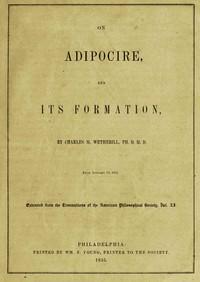|
|
Read this ebook for free! No credit card needed, absolutely nothing to pay.Words: 114602 in 108 pages
This is an ebook sharing website. You can read the uploaded ebooks for free here. No credit cards needed, nothing to pay. If you want to own a digital copy of the ebook, or want to read offline with your favorite ebook-reader, then you can choose to buy and download the ebook.

: On adipocire and its formation by Wetherill Charles Mayer - Adipocere; Fatty acids; Postmortem changes@FreeBooksThu 08 Jun, 2023 Transcriber's Notes Obvious typographical errors have been silently corrected. Variations in hyphenation and accents have been standardised but all other spelling and punctuation remains unchanged. ON ADIPOCIRE, AND ITS FORMATION. BY CHARLES M. WETHERILL, PH.D. M.D. The formation of fat is interesting, both from a chemical and a physiological point of view. The relation of lignine starch and sugar to alcohol, afforded reasons for Liebig's theory of the formation of fat in the body. Recent experiments by Liebig, Bopp, Guckelberger, Keller and others, on the formation of the lower terms of the series of fatty acids by the oxidation and putrefaction of the blood-forming substances, rendered possible the formation of the higher members, from albumen, fibrin and caseine, by similar means, for example, by a less intense degree of oxidation. It was thought that the study of adipocire, with a view to this question, would perhaps throw some light upon it; and upon reading all the articles within my reach, upon this body, from the time of its discovery by Fourcroy, I find a considerable difference of opinion with regard to it. In 1785, Fourcroy examined a portion of a liver which had hung for ten years in the air in the laboratory of de la Salle; it was fatty, smooth, and unctuous to the touch. Potash lye dissolved a portion of the liver completely, forming a soap. Subsequently, when he had examined the fat of grave yards, and spermaceti, he proposed to name these three fats, viz.: of biliary calculi, spermaceti, and from grave yards, adipocire, considering them to be identical, and possessing an intermediate nature between fat and wax. Chevreul, in his fifth Memoire, corrects this error, and calls the fat of gall stones cholesterine, and that of spermaceti cetine. In 1786-7, Fourcroy had an opportunity of studying the fat of grave yards, in the removal of the bodies from the Cemeti?re des Innocens, a work which lasted for two years, and which was supervised by Dr. Thouret, who was placed there to care for the health of the workmen. The substance was abundantly found, and especially in the "fouilles," or ditches, where the slightly made coffins of the poorer classes had been piled one upon another; the trench being open for some time until it was filled with bodies, when it was covered with a slight quantity of earth; on opening the trenches after some fifteen years, the bodies were converted into adipocire; they were flattened by mutual pressure, and had impressions on their surface of the grave clothes. Fourcroy's analysis proved it to be a soap of ammonia, with phosphate of lime, and the fat, melted at 52.5? C. He supposed adipocire to arise from the putrefaction of all animal matter, except hair, nails, and bones, for he states that in the carcasses of all animals exposed upon the borders of pieces of water, a fatty, white, fusible substance resembling spermaceti is found. Perhaps the earliest record on this change from flesh to fat, is to be found in Lord Bacon's Sylva Sylvarum, where he says, "Nearly all flesh may be turned into a fatty substance, by cutting it into pieces and putting it into a glass covered with parchment, then letting the glass stand six or seven hours in boiling water." This may be a profitable experiment for making fat or grease; but then it must be practised upon such flesh as is not edible, viz.: that of horses, dogs, bears, foxes, badgers, &c. George Smith Gibbes, 1794, observed that in Oxford, in the pits where were thrown the remains of dissections, and at the bottom of which flowed a gentle current of water, large quantities of adipocire were formed. He placed a piece of beef in the river in a box pierced with holes, and also a piece in which putrefaction in the air had commenced, and adipocire resulted in both cases. He proposes to make use of this property to utilize the dead bodies of animals, and states that nitric acid will effect the same change in three or four days. John Bostock digested muscular fibre with dilute nitric acid, and washed with water: the result was a clear, yellow fat, of the consistence of tallow, melting at 33? C. Is less soluble in alcohol than Fourcroy's substance: the greater part deposits nearly white on cooling, and the residue can be precipitated from the alcohol by water. Hot ether dissolves it and abandons it on cooling; caustic alkali forms a soap; ammonia dissolves but little of the fat. Chevreul, on repeating this experiment with pure fibrine, could obtain no fat. Hartkol, experimented for twenty-five years on adipocire, and concluded that it is not formed in dry grounds, that in moist earth the fat does not increase, but changes to a fetid mass, incapable of being made into candles. Animals in running water leave a fat after three years, which is more abundant in the intestines than in the muscles, and more fat is formed in stagnant, than in running water. Free books android app tbrJar TBR JAR Read Free books online gutenberg More posts by @FreeBooks
: Remember me Kama! by Kubilius Walter Giunta John Illustrator - Science fiction; Short stories; Human-alien encounters Fiction@FreeBooksThu 08 Jun, 2023

: Nothing by Wollheim Donald A Musacchia John B Illustrator - Science fiction; Short stories; Bombings Fiction; World War 1939-1945 Fiction@FreeBooksThu 08 Jun, 2023
|
Terms of Use Stock Market News! © gutenberg.org.in2025 All Rights reserved.






